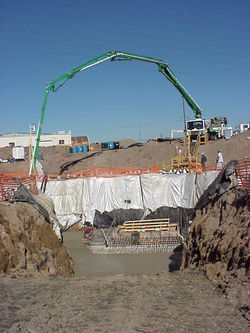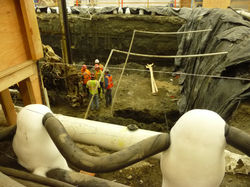Foundation Excavations
Foundations for residential and industrial applications typically have a special blend of requirements based on the unique situation of each site. Some are community and environmentally sensitive like a number of upscale residential projects on lake shores we have completed. Some are inside active industrial buildings like the Nucor steel plant in Nebraska, or the Boeing Company commercial airplane hangar in Washington.

The versatility and non-invasive nature of our system combined with its engineered strength has allowed us to perform work in active container ship yards in Los Angeles, CA, railroad refueling yards near Oakland, CA, in the court yard of the Seattle Children’s Hospital, through embankments supporting active and critical Union Pacific freight lines, and near fragile buildings at Bangor Nuclear Submarine Base on the Hood Canal.
In all cases, the successful performance of our system was critical to the continued operation of the facilities and to the safety of the workers and the public.
Case Examples:
The Project
A new coal handling facility for Public Service of Colorado in Englewood, Colorado consisted of a large structure buried about 25 feet deep into which coal from trains is dumped. The coal is then transported up into stockpiles via a long, inclined conveyor. The excavation for the facility was T-shaped with the approximate overall plan dimension of 85 by 120 feet.
Arapahoe Coal Handling Facility
The Results
The 5-foot thick frozen soil was formed in about 4 weeks. With added angled freeze pipes at selected locations, the wall effectively shored the site with negligible wall movement, even next to large cranes. Ground water was significantly cutoff limiting the flow quantities to within the permitted amount. This allowed the contractor to successfully complete the facility within the project schedule.
The Challenge
The contractor was faced with having to come up with a shoring solution that would cut off groundwater inflow to stay within the limited dewatering quantities allowed in the permit. Sheet piles were not feasible because of the presence of large cobbles in the soil and dense claystone below the excavation level.
The Solution
A thick frozen soil wall was used to shore the excavation perimeter and cut off groundwater flow into the excavation to an acceptable amount. Freeze pipes were installed into the claystone around the entire site perimeter using auger drilling methods that allowed the freeze to extend well into the claystone and effectively cutoff most of the groundwater flow.
 |  |  |
|---|---|---|
 |  |  |
Boeing PB-4 Paint Booth
The Challenge
Limiting overhead inside the building along with needing to extended the shoring below the existing pile caps without damaging the foundation elements ruled out conventional sheets. Groundwater was within 3 feet of the ground surface causing severe dewatering restrictions.
The Solution
SoilFreeze was able to overcome these challenges due to our ability to install freeze pipes below existing pile caps without damaging them and in relatively low overhead conditions. A frozen soil wall was installed around the site perimeter and extended to a depth of 40 feet in an attempt to cutoff or limit the amount of groundwater inflow from below the 15-foot deep excavation. Angled freeze pipes were installed at select locations to limit the amount of lateral wall movement.
The Project
A paint booth in which new 737 airplanes would be painted was planned inside an existing hangar building at the Boeing Renton Plant. The paint booth required a new below-ground basement foundation consisting of a large concrete mat (120 X 40 feet in plan) and perimeter walls supporting deep piles. Shoring for the foundations would be inside the existing build and would extend beneath the piles caps.
 |  |  |
|---|---|---|
 |  |  |
 |  |
The Results
The frozen soil wall effectively retained soil and groundwater for the foundation excavation. Because of soil variability, groundwater cutoff into the excavation from below was not complete. However, the frozen soil did limit the rate of inflow to an acceptable amount and kept the contractor below permit levels. Existing building slabs and foundations were unaffected from the excavation because the frozen soil wall had limited ground movements to a negligible amount.


